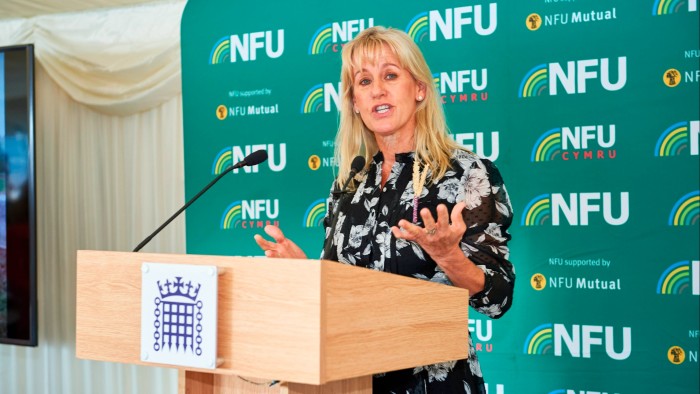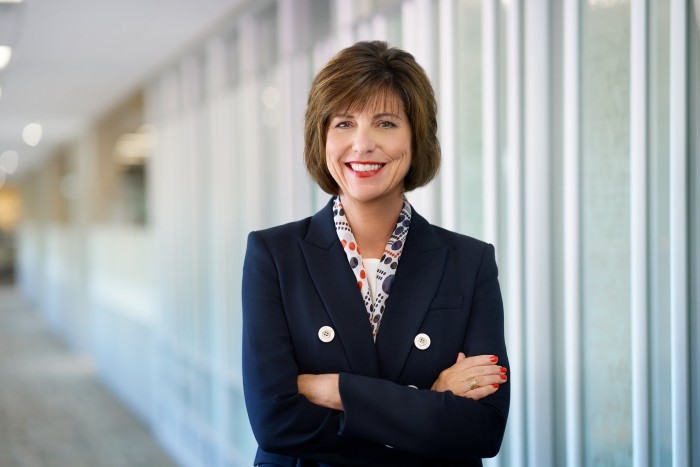Women secure higher profile in agriculture

Roula Khalaf, Editor of the FT, selects her favourite stories in this weekly newsletter.
For much of her three decades working in the food and agriculture sector, Ruth Kimmelshue had few female colleagues. “For the vast majority of my career, I was the only woman in the room,” says Kimmelshue, who leads Cargill’s animal nutrition and health business — and is the first woman to head one of the US agricultural trader’s five global enterprises.
Women have, of course, always been at the heart of farming. In an industry dominated by family businesses — in the US, for instance, they account for 98 per cent of farms and generate 83 per cent of production by value — women take on everything from lambing to accounting and strategic planning. Yet it is only in recent times that they have started to emerge from behind the scenes.
“Women have always been there running things,” points out Sarah Bell, an independent farmer and member of the national crops board at the UK’s National Farmers’ Union. “But, because they’re balancing farming with caring and cooking and all the other things they have to do, they haven’t tended to get into the out-front leadership world — they’re just too busy.”
In the past few years, however, more women have been securing top jobs in the sector. They include NFU president Minette Batters, as well as corporate leaders, such as Beth Ford, president and CEO of Land O’Lakes, the US farmer-owned co-operative, and Sarah Mukherjee, former co-chair of the UK’s influential Oxford Farming Conference.
“Women have always been in this industry, but they haven’t had that visibility,” says Orla McAleer, chief culture officer at Alltech, the US animal feed and crop nutrition company. “We’re definitely starting to see that now.”
No single factor is behind this change, but one of the key drivers has been agriculture’s own transformation. “It used to be highly mechanised,” says Batters. “And now it’s a very technical industry.”
As gruelling physical work, mucky conditions and heavy machinery have given way to ag-tech and digitisation, so the sector has been attracting a more diverse cohort of employees — including women.
Evidence of this can be seen in the growing number of women attending the UK’s oldest agricultural college, the Royal Agricultural University in Cirencester, England. In the 2022/23 academic year, female students made up 46 per cent of the cohort, up from 42 per cent in 2019/20.
This, in turn, is changing the industry’s gender profile. “Our students are going out to professional jobs in the sector, whether in agronomy, research or leadership in companies,” says Nicola Cannon, an RAU professor of agriculture.
And, while she sees the push for more sustainable farming practices as equally attractive to men, some believe that women, in particular, are drawn to the challenge of feeding a growing global population while fighting climate change and minimising biodiversity loss.
“Solving that problem is compelling,” says Kimmelshue. “It creates a really interesting opportunity to attract talent that may not have naturally found its way into the food and agriculture space.”

Bringing more women into agriculture is something policymakers are keen to do. Last year, for example, the Irish government brought together corporate leaders and agriculture ministers from Ireland and Germany for a national dialogue on policies that could help attract more women to the sector.
Meanwhile, groups such as Women in Food and Agriculture — which runs events and offers a mentorship programme — have emerged to push for more prominent roles for women in the sector, says McAleer, who is a WFA ambassador.
In big agribusinesses, efforts to promote gender equality in the workforce and in leadership teams — such as establishing mentorship programmes and employee affinity groups — mirror those of other sectors.
At Cargill, for example, a women’s network uses advocacy and sponsorship to help female staff advance within the company and across its global supply chains. “None of this happens without significant intentional effort,” says Kimmelshue.
Something else that agriculture shares with other sectors is the pressure to offer a better work-life balance. “Being a woman leader shouldn’t come at the expense of the family,” stresses Sarah Lockwood, global regenerative agriculture programme director at Danone, the French group behind consumer goods such as Evian bottled water and Activia yoghurt.
Nevertheless, when it comes to what prevents women from entering and succeeding in agriculture, some of the obstacles are specific to the industry.
Batters sees the decline of rural economies as problematic for women working in agriculture. “It’s quite isolated and lonely,” she notes. “And that can be challenging.”
And, while some celebrate the presence of more women at the top of large agricultural companies and institutions, Bell says that, lower down the industry ladder, women need to be more visible.
She points to the industry events that farmers regularly attend, where she sees too few women on stage or leading the sessions. “This industry needs all the talent round the table,” she says. “That’s about making sure the door is open for everybody.”

Comments